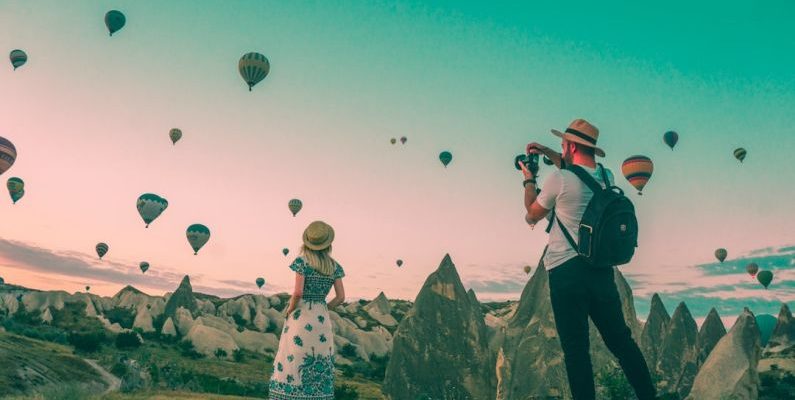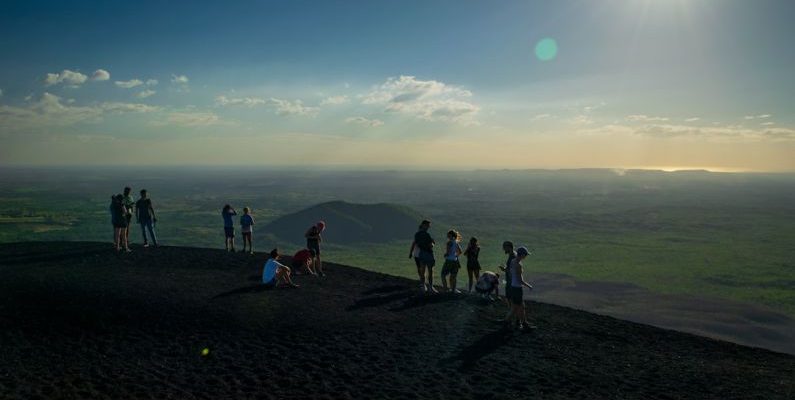Traveling internationally can be an exciting and enriching experience, but it also requires careful planning and preparation. One essential aspect of international travel is choosing the right luggage to accompany you on your journey. With so many options available on the market, selecting the best luggage for international travel can be a daunting task. However, by considering factors such as size, durability, security features, and ease of maneuverability, you can find the perfect travel companion for your adventures abroad.
Author: vview
In Eco-Tourism
Located in the Pacific Ocean, the Galápagos Islands are renowned for their unique biodiversity and the groundbreaking work of Charles Darwin. With over 97% of the land area designated as a national park, these islands are a haven for a wide array of species found nowhere else on Earth. However, the delicate ecosystems of the Galápagos face numerous threats, including invasive species, climate change, and over-tourism. In response to these challenges, various conservation efforts have been implemented to preserve the natural beauty and ecological significance of this iconic archipelago.
**Protecting Endemic Species**
One of the primary focuses of conservation efforts in the Galápagos Islands is protecting the endemic species that call this remote archipelago home. These species, such as the Galápagos giant tortoise and the marine iguana, have evolved in isolation and are particularly vulnerable to threats from introduced predators and habitat destruction. Conservation organizations work tirelessly to monitor and protect these unique animals, implementing measures such as captive breeding programs and habitat restoration to ensure their survival for future generations.
**Eradicating Invasive Species**
Invasive species pose a significant threat to the delicate balance of ecosystems in the Galápagos Islands. Rats, goats, and introduced plants compete with native species for resources, leading to habitat degradation and loss of biodiversity. To combat this threat, conservationists have implemented eradication programs to remove invasive species from key areas of the islands. These efforts have already shown positive results, with native species rebounding in areas where invasives have been successfully eliminated.
**Sustainable Tourism Practices**
The Galápagos Islands are a popular destination for eco-tourism, attracting thousands of visitors each year who come to witness the unparalleled beauty of the natural world. However, the influx of tourists can have negative impacts on the fragile ecosystems of the islands if not managed properly. To ensure that tourism remains sustainable, conservation organizations and local authorities have implemented strict regulations on visitor numbers, activities, and infrastructure development. By promoting responsible tourism practices, these efforts aim to minimize the environmental footprint of visitors while still allowing them to experience the unique wonders of the Galápagos.
**Climate Change Adaptation**
As global temperatures rise, the Galápagos Islands are not immune to the effects of climate change. Rising sea levels, increasing ocean temperatures, and more frequent extreme weather events pose a threat to the delicate ecosystems of the archipelago. Conservation efforts in the Galápagos now include measures to mitigate and adapt to the impacts of climate change. These efforts range from coral reef restoration projects to monitoring the migration patterns of species affected by changing environmental conditions. By taking proactive steps to address the challenges posed by climate change, conservationists hope to safeguard the unique biodiversity of the Galápagos Islands for generations to come.
**Community Involvement and Education**
Conservation efforts in the Galápagos Islands are not limited to protecting wildlife and habitats; they also involve engaging with local communities and educating the public about the importance of conservation. Community-based initiatives empower residents to participate in conservation activities, such as beach cleanups, tree planting, and environmental education programs. By fostering a sense of stewardship among the local population, these efforts help to create a culture of conservation that extends beyond the boundaries of the national park.
**Preserving a Natural Wonder**
In conclusion, the Galápagos Islands are a natural wonder that must be protected for future generations to enjoy. Through a combination of targeted conservation efforts, including protecting endemic species, eradicating invasive species, promoting sustainable tourism practices, adapting to climate change, and engaging with local communities, conservationists are working tirelessly to ensure the long-term health and biodiversity of this unique archipelago. By supporting these efforts and raising awareness about the importance of conservation, we can all play a role in preserving the Galápagos Islands for years to come.
Havana, the vibrant capital city of Cuba, is a place where history comes alive in every cobblestone street and colonial building. Designated as a UNESCO World Heritage Site, Havana's historic districts serve as a living museum that offers a glimpse into the city's rich past and cultural heritage. From the colorful facades of Old Havana to the grandeur of Vedado, each district has its own unique charm and story to tell.
Old Havana: A Time Capsule of Colonial Splendor
The heart of Havana's historic districts is Old Havana, or Habana Vieja, a well-preserved colonial neighborhood that dates back to the 16th century. Walking through the narrow streets of Old Havana feels like stepping back in time, with its historic plazas, elegant baroque churches, and majestic fortresses. The iconic Plaza de la Catedral, with its stunning cathedral and surrounding colonial buildings, is a must-visit spot that encapsulates the beauty and history of Old Havana. Exploring Old Havana's cobblestone streets, visitors will encounter charming cafes, art galleries, and local markets that offer a taste of Cuban culture. The restoration efforts in Old Havana have helped preserve its architectural heritage, making it a living testament to the city's past.Vedado: The Modernist Jewel of Havana
In contrast to the colonial charm of Old Havana, Vedado represents a more modern side of the city's history. Developed in the early 20th century, Vedado is known for its wide avenues, lush parks, and eclectic mix of architectural styles. The district is home to many iconic landmarks, including the famous Hotel Nacional and the bustling Malecón waterfront promenade. Vedado's architecture reflects the influence of Art Deco, Neoclassical, and Modernist styles, creating a dynamic urban landscape that is a delight to explore. The district is also a cultural hub, with theaters, art galleries, and jazz clubs that showcase Havana's vibrant arts scene.Miramar: The Opulent Suburb of Havana
Located west of Vedado, Miramar is a residential neighborhood that exudes elegance and luxury. Developed in the early 20th century as a playground for the wealthy elite, Miramar is characterized by its grand mansions, tree-lined boulevards, and waterfront views. The district is home to embassies, diplomatic residences, and upscale restaurants that cater to a more affluent clientele. Miramar's architecture is a blend of Spanish, Moorish, and Art Deco influences, creating a picturesque setting that is reminiscent of a bygone era. Strolling through Miramar's leafy streets, visitors can admire the opulent mansions and beautifully landscaped gardens that define the district's upscale ambiance.The Vibrant Present and Promising Future of Havana's Historic Districts
While Havana's historic districts are steeped in history, they are also vibrant and evolving spaces that reflect the city's dynamic present. From the lively music scene in Old Havana to the trendy cafes in Vedado, these districts are alive with energy and creativity. As Havana continues to undergo revitalization efforts, the historic districts are being carefully preserved and restored, ensuring that future generations can continue to experience their timeless beauty. In conclusion, Havana's historic districts are more than just tourist attractions – they are living, breathing spaces that embody the spirit of Cuba's past, present, and future. Whether you're wandering through the charming streets of Old Havana, admiring the architectural marvels of Vedado, or soaking in the luxury of Miramar, each district offers a unique glimpse into Havana's rich heritage. In a city where history is intertwined with everyday life, exploring the historic districts of Havana is a journey through time that should not be missed.
In Eco-Tourism
In today's world, the tourism industry is rapidly evolving, with a growing emphasis on sustainability and environmental consciousness. As travelers become more aware of their impact on the planet, the demand for eco-friendly and sustainable tourism options is on the rise. One significant aspect of this shift towards sustainability is the increasing role of renewable energy in the tourism sector.
**Sustainable Practices in Tourism**
Sustainable tourism practices aim to minimize the negative impact of tourism on the environment and local communities while maximizing the benefits. From reducing carbon emissions to preserving natural habitats, the adoption of renewable energy sources plays a crucial role in achieving these sustainability goals. As the tourism industry continues to expand, the need for sustainable solutions becomes more pressing.
**Benefits of Renewable Energy in Tourism**
The integration of renewable energy sources in the tourism sector offers a wide range of benefits. One of the most significant advantages is the reduction of carbon emissions. Traditional energy sources, such as fossil fuels, contribute to climate change and air pollution. By switching to renewable energy sources like solar or wind power, tourism businesses can significantly lower their carbon footprint and help combat global warming.
Moreover, renewable energy provides a reliable and cost-effective alternative to conventional energy sources. In remote or off-grid locations where access to electricity may be limited, renewable energy systems offer a sustainable solution. This is particularly beneficial for eco-lodges, resorts, and other tourism facilities located in natural settings where preserving the environment is a top priority.
**Enhancing Visitor Experience**
The integration of renewable energy technologies can also enhance the overall visitor experience. Many tourists today are seeking authentic and immersive travel experiences that connect them with nature and local cultures. By utilizing renewable energy sources, tourism businesses can offer visitors a unique opportunity to engage with sustainable practices and learn about the importance of environmental conservation.
For example, eco-friendly accommodations powered by solar panels or geothermal energy not only reduce environmental impact but also provide guests with a memorable and educational experience. Visitors are increasingly drawn to destinations that prioritize sustainability, making renewable energy a valuable asset for attracting and retaining eco-conscious travelers.
**Case Studies: Renewable Energy Success Stories**
Several destinations around the world have already embraced renewable energy solutions in their tourism sector with impressive results. For instance, Costa Rica has made significant strides in transitioning to renewable energy sources, with over 98% of its electricity coming from renewable sources. This commitment to sustainability has positioned Costa Rica as a leading ecotourism destination, attracting visitors from around the globe.
Similarly, the Maldives, a small island nation highly vulnerable to climate change, has invested in solar power and other renewable energy technologies to reduce its reliance on imported fossil fuels. By harnessing its abundant sunshine and wind resources, the Maldives has not only decreased its carbon footprint but also enhanced the resilience of its tourism infrastructure against the impacts of climate change.
**Challenges and Future Outlook**
Despite the numerous benefits of renewable energy in tourism, there are challenges that must be addressed to facilitate wider adoption. Initial investment costs, technological limitations, and regulatory barriers can pose obstacles to implementing renewable energy solutions in the tourism sector. However, as the industry continues to prioritize sustainability, innovative approaches and partnerships are emerging to overcome these challenges.
Looking ahead, the future of renewable energy in tourism appears promising. With advancements in technology and a growing awareness of the importance of sustainability, more tourism businesses are likely to integrate renewable energy solutions into their operations. By leveraging the power of renewable energy, the tourism industry can not only reduce its environmental impact but also create unique and memorable experiences for travelers seeking responsible and authentic travel options.
**In Summary**
Renewable energy plays a crucial role in shaping the future of sustainable tourism. From reducing carbon emissions to enhancing visitor experiences, the adoption of renewable energy sources offers a wide range of benefits for the tourism industry. By embracing renewable energy technologies, destinations can attract eco-conscious travelers, minimize their environmental impact, and contribute to a more sustainable and resilient tourism sector. As the demand for responsible travel continues to grow, renewable energy will undoubtedly play an increasingly important role in shaping the tourism industry of tomorrow.
Embarking on the Appalachian Trail presents hikers with a true test of endurance and a chance to connect with nature on an unparalleled level. Spanning approximately 2,200 miles from Georgia to Maine, this iconic trail offers a journey filled with breathtaking landscapes, physical challenges, and a sense of accomplishment that is unmatched. For those seeking an epic adventure that pushes boundaries and immerses them in the beauty of the great outdoors, hiking the Appalachian Trail is an experience like no other.
Challenging Terrain and Varied Landscapes
The Appalachian Trail winds through some of the most diverse landscapes in the United States, treating hikers to a range of terrains and ecosystems along the way. From the lush forests of the southern Appalachians to the rugged peaks of New Hampshire and Maine, each section of the trail offers its own unique beauty and challenges. Hikers will navigate steep climbs, rocky terrain, and river crossings, all while taking in panoramic views that make every step worth the effort.Wildlife Encounters and Natural Wonders
One of the most captivating aspects of hiking the Appalachian Trail is the opportunity to witness a wide array of wildlife in their natural habitats. From black bears and deer to elusive salamanders and birds of prey, the trail is teeming with biodiversity that creates a sense of wonder and awe. Along the way, hikers may encounter cascading waterfalls, pristine lakes, and stunning vistas that serve as reminders of the power and beauty of the natural world.Community and Camaraderie
Despite the solitary nature of long-distance hiking, the Appalachian Trail fosters a unique sense of community among those who undertake the journey. Hikers from all walks of life come together on the trail, forming bonds based on shared experiences and a mutual love for the outdoors. Trail towns and shelters provide opportunities for rest, resupply, and connection with fellow hikers, creating a supportive network that enhances the overall hiking experience.Physical and Mental Challenges
Hiking the Appalachian Trail is not for the faint of heart. The physical demands of walking over 2,000 miles through rugged terrain require endurance, strength, and determination. Long days of hiking, unpredictable weather conditions, and the constant weight of a backpack can take a toll on the body, pushing hikers to their limits both physically and mentally. Overcoming these challenges fosters a sense of resilience and self-reliance that can be carried forward long after the hike is completed.Personal Growth and Reflection
As hikers make their way along the Appalachian Trail, they are given the gift of time and space to reflect on their lives, goals, and priorities. The solitude of the trail allows for introspection and self-discovery, leading to personal growth and a deeper understanding of oneself. Whether seeking clarity on a major life decision or simply enjoying the simplicity of life on the trail, hiking the Appalachian Trail provides a transformative experience that stays with hikers long after they have reached the end.A Journey to Remember
Hiking the Appalachian Trail is more than just a physical challenge; it is a transformative journey that tests limits, fosters connection with nature, and cultivates personal growth. From the rugged peaks of the White Mountains to the rolling hills of Virginia, each step along the trail is a reminder of the beauty and resilience of the natural world. For those who dare to take on this epic adventure, the Appalachian Trail offers an experience that is as rewarding as it is unforgettable.
In Travel Gear
Travel photography is a thrilling way to capture the beauty of the world around us. One of the essential elements in creating stunning travel photos is having the right camera gear. Whether you're a beginner or a seasoned pro, having the best camera gear for travel photography can make a significant difference in the quality of your images. In this article, we will explore the must-have camera gear for travel photography that will help you capture unforgettable moments on your adventures.
Compact Camera: The Perfect Travel Companion
When it comes to travel photography, a compact camera is a versatile and lightweight option that allows you to capture high-quality images without the bulk of a DSLR. Compact cameras are ideal for capturing everyday moments, landscapes, and street scenes while on the go. Look for a compact camera with advanced features such as a large sensor, manual controls, and a zoom lens to enhance your creativity and produce professional-looking images.Mirrorless Camera: The Best of Both Worlds
For photographers who desire the image quality of a DSLR without the weight and bulk, a mirrorless camera is the perfect solution. These cameras combine the portability of a compact camera with the image quality and versatility of a DSLR. With a mirrorless camera, you can enjoy interchangeable lenses, advanced autofocus systems, and high-resolution sensors, making it an excellent choice for travel photography enthusiasts looking to elevate their craft.Wide-Angle Lens: Capture the Full Picture
A wide-angle lens is a must-have for travel photographers who want to capture expansive landscapes, architecture, and interiors. This type of lens allows you to fit more of the scene into the frame, making it perfect for capturing breathtaking vistas and tight spaces. Whether you're photographing a majestic mountain range or a bustling city street, a wide-angle lens will help you convey the grandeur and depth of the scene in your photos.Telephoto Lens: Bring Distant Subjects Closer
When you're exploring new destinations, a telephoto lens can help you capture distant subjects with clarity and detail. Whether you're photographing wildlife, sports events, or architectural details from afar, a telephoto lens allows you to zoom in on the action and bring distant subjects closer to your camera. Look for a telephoto lens with image stabilization to minimize camera shake and ensure sharp images, especially in low-light conditions.Tripod: Stability for Sharp Images
A sturdy tripod is an essential tool for travel photographers who want to capture sharp images in various lighting conditions. Whether you're shooting long exposures at sunrise or sunset, capturing night scenes, or taking self-portraits, a tripod provides stability and eliminates camera shake, resulting in clear and crisp images. Choose a lightweight and compact tripod that fits easily in your travel bag and is easy to set up, so you can capture stunning photos wherever your adventures take you.Camera Bag: Protect Your Gear on the Go
Investing in a quality camera bag is essential for travel photographers who want to protect their gear while on the move. A well-designed camera bag provides padding and compartments to safely store your camera body, lenses, accessories, and personal items. Look for a camera bag that is durable, weather-resistant, and comfortable to carry for long periods, so you can focus on capturing moments without worrying about the safety of your equipment.Editing Software: Enhance Your Images
Once you've captured your travel photos, editing software allows you to enhance and refine your images to achieve the desired look and feel. Whether you're adjusting exposure, color balance, or cropping your photos, editing software gives you the tools to unleash your creativity and elevate your travel photography to the next level. Choose a user-friendly editing program that suits your skill level and workflow, so you can bring out the best in your images and create stunning visual stories of your adventures. In conclusion, having the best camera gear for travel photography can make a significant difference in the quality of your images and the overall enjoyment of your photographic journey. By investing in compact cameras, mirrorless cameras, wide-angle and telephoto lenses, tripods, camera bags, and editing software, you can capture unforgettable moments and create stunning visual stories of your travels. With the right camera gear in hand, you'll be ready to explore the world with a creative eye and capture the beauty and essence of each destination you visit. Travel photography is all about capturing moments that tell a story, and with the best camera gear at your disposal, you can transform those moments into timeless memories that will last a lifetime.
In Solo Travel
Embarking on a solo travel adventure is a unique experience that offers the opportunity to create unforgettable memories that will last a lifetime. Traveling alone allows you to fully immerse yourself in new cultures, push your boundaries, and discover hidden gems without any compromises. Here are some tips on how to make the most of your solo travel journey and create memories that will stay with you forever.
Embrace Spontaneity
One of the joys of solo travel is the freedom to be spontaneous. Embrace the unexpected and allow yourself to wander off the beaten path. Some of the most memorable experiences often happen when you least expect them. Whether it's stumbling upon a local festival, striking up a conversation with a stranger, or taking a detour to explore a hidden alleyway, embracing spontaneity can lead to incredible memories that you would have otherwise missed.Immerse Yourself in Local Culture
To truly make your solo travel experience unforgettable, immerse yourself in the local culture. Try local cuisine, learn a few phrases in the local language, participate in cultural activities, and interact with the locals. By immersing yourself in the daily life of the destination, you'll gain a deeper understanding of the culture and create meaningful connections with the people you meet along the way. These interactions can lead to unforgettable moments and a greater appreciation for the destination you're exploring.Step Out of Your Comfort Zone
Solo travel is the perfect opportunity to step out of your comfort zone and challenge yourself in new ways. Whether it's trying an adrenaline-pumping activity, embarking on a solo hike, or navigating through a bustling market, pushing your boundaries can lead to personal growth and unforgettable memories. Stepping out of your comfort zone allows you to discover your strengths, overcome fears, and gain a newfound sense of confidence that will stay with you long after your journey ends.Capture Moments Through Photography
Photography is a powerful tool for creating lasting memories of your solo travel adventures. Take the time to capture the beauty of the destinations you visit, from stunning landscapes to intricate details that catch your eye. Photography allows you to document your experiences, share them with others, and revisit them whenever you want to relive the moments. Whether you're using a professional camera or simply your smartphone, capturing moments through photography can help you create a visual diary of your solo travel journey.Connect with Other Travelers
Although solo travel offers the chance to explore independently, connecting with other travelers can enhance your experience and create unforgettable memories. Joining a group tour, staying in a hostel, or attending local events are great ways to meet like-minded individuals and form new friendships along the way. Sharing stories, exchanging travel tips, and exploring together can add a new dimension to your solo travel adventure and create bonds that can last beyond the trip.Reflect and Appreciate Your Journey
As your solo travel adventure comes to an end, take the time to reflect on the experiences you've had and the memories you've created. Appreciate the personal growth, the challenges you've overcome, and the connections you've made with others. Whether you journal about your journey, create a scrapbook of mementos, or simply take a moment to soak in the memories, reflecting on your solo travel experience can help you appreciate the journey you've embarked on and the unforgettable moments you've collected along the way. In summary, solo travel offers a unique opportunity to create unforgettable memories that will enrich your life and broaden your perspective. By embracing spontaneity, immersing yourself in local culture, stepping out of your comfort zone, capturing moments through photography, connecting with other travelers, and reflecting on your journey, you can make the most of your solo travel adventure and create lasting memories that will stay with you for years to come. So, pack your bags, embrace the unknown, and get ready to embark on a solo travel journey filled with unforgettable moments and life-changing experiences.
In Travel Tips
Planning for an extended vacation is exciting, but amid the flurry of packing and last-minute arrangements, it's crucial not to overlook the security of your home while you're away. Ensuring your home is safe and protected will provide peace of mind during your travels and help prevent any potential security breaches. By taking a few precautionary measures before you depart, you can significantly reduce the risk of a break-in or other security issues. Here are some tips to secure your home before embarking on a long trip.
Install a Home Security System
Investing in a home security system is one of the most effective ways to safeguard your property while you're away. Modern security systems come equipped with features such as motion sensors, cameras, and alarms that can deter potential intruders and alert you or the authorities in case of any suspicious activity. Make sure to activate your security system before leaving and inform your monitoring service of your travel plans.Secure Doors and Windows
Before you leave, double-check that all doors and windows are securely locked. Consider installing deadbolts on exterior doors for added security. Sliding glass doors can be vulnerable entry points, so placing a wooden dowel or metal bar in the track can prevent them from being forced open. Reinforcing windows with security film or locks can also help deter intruders.Arrange for Mail and Newspaper Delivery
A pile of newspapers on your doorstep or an overflowing mailbox is a telltale sign that no one is home. Contact your newspaper provider and the postal service to temporarily hold your deliveries while you're away. Alternatively, ask a trusted neighbor or friend to collect your mail and newspapers regularly to maintain the appearance that someone is still at home.Set Timers for Lights and Electronics
A dark, unlit house is an invitation for burglars. Create the illusion of occupancy by using timers for lights, TVs, and radios. Set them to turn on and off at different times throughout the day to simulate your usual routine. Smart home devices can also be programmed remotely to control lights and electronics from your smartphone.Inform a Trusted Neighbor or Friend
Having a trusted neighbor or friend keep an eye on your property can provide an extra layer of security. Provide them with a spare key and your contact information in case of emergencies. Ask them to check in periodically, draw curtains, and park their car in your driveway to give the impression that someone is home.Secure Valuables and Important Documents
Store valuable items such as jewelry, cash, and important documents in a secure safe or safety deposit box before you leave. Avoid leaving valuables in obvious locations that are easily accessible to intruders. Taking inventory of your possessions and documenting them with photographs can also be helpful in the event of theft or damage.Keep Social Media Posts to a Minimum
While it's tempting to share your travel plans and vacation photos on social media, doing so can inadvertently advertise that your home is unattended. Refrain from posting about your trip until you return to avoid tipping off potential burglars. Adjust your privacy settings to limit who can see your posts to trusted friends and family only.Conclusion: Returning to a Safe Haven
By taking the time to secure your home before a long trip, you can enjoy your vacation with the confidence that your property is protected. Implementing these proactive measures will not only deter intruders but also ensure that you return to a safe and secure home. Remember, a little preparation goes a long way in safeguarding your peace of mind while you're away.
In Travel Gear
Traveling to new and exciting destinations can be a thrilling experience, but one thing that often gets overlooked is the quality of the water available. Clean and safe drinking water is essential for maintaining good health, especially when exploring unfamiliar places. Waterborne illnesses can quickly turn a dream vacation into a nightmare. This is where water purification systems for travelers come into play, offering a convenient and reliable way to ensure that the water you consume is safe and free from harmful contaminants.
### The Importance of Water Purification Systems
When traveling, especially to developing countries or rural areas, the quality of tap water may not meet the standards you are accustomed to. Even in seemingly modern cities, the water supply can be contaminated with bacteria, viruses, parasites, and other pollutants that can cause gastrointestinal issues and other health problems. Using a water purification system can provide peace of mind and protect you from potential risks associated with consuming unsafe water.### Types of Water Purification Systems
There are several types of water purification systems designed specifically for travelers, each offering unique benefits and features. Understanding the differences between these systems can help you choose the one that best suits your needs.#### Water Filter Bottles
Water filter bottles are a popular choice for travelers as they are portable, easy to use, and effective in removing most common contaminants found in water sources. These bottles typically use a filtration system that can capture bacteria, protozoa, and sediment, providing you with clean and safe drinking water on the go. Some models even come with built-in UV lights to kill viruses, adding an extra layer of protection.#### Water Purification Tablets
Water purification tablets are another convenient option for travelers looking to disinfect water quickly and effectively. These tablets typically contain chemicals such as chlorine dioxide or iodine, which can kill bacteria, viruses, and parasites present in untreated water. While they may alter the taste of the water slightly, they are lightweight and easy to carry, making them ideal for backpackers and hikers.#### Portable Water Filters
Portable water filters are compact devices that use a filtration system to remove impurities from water sources such as rivers, lakes, and streams. These filters can effectively remove bacteria, protozoa, and some viruses, providing you with safe drinking water wherever your adventures take you. Some models come with a pump mechanism, while others rely on gravity for filtration, offering flexibility in terms of usage.### Choosing the Right Water Purification System
When selecting a water purification system for your travels, there are several factors to consider to ensure you make the right choice. Think about the type of activities you will be engaging in, the duration of your trip, and the water sources available in your destination. It's also essential to consider factors such as portability, ease of use, maintenance requirements, and the level of filtration provided by the system.### Tips for Using Water Purification Systems
Once you have chosen a water purification system, it's essential to follow the manufacturer's instructions for optimal performance. Here are some additional tips to help you make the most of your chosen system: - Always carry extra purification supplies in case of emergencies. - Inspect your system regularly for any signs of wear or damage. - Clean and maintain your system according to the manufacturer's guidelines. - Be cautious of water sources that may be contaminated, such as those near industrial sites or agricultural areas. - When in doubt, always err on the side of caution and purify your water before consumption.### Safe and Enjoyable Travels
Water purification systems for travelers offer a convenient and effective way to ensure that the water you drink is safe and free from harmful contaminants. By choosing the right system for your needs and following best practices for use, you can enjoy your travels with peace of mind, knowing that you are taking proactive steps to safeguard your health. Remember, staying hydrated is crucial while on the road, and having a reliable water purification system by your side can make all the difference in your overall travel experience. Stay safe, stay hydrated, and happy travels!
Imagine hurtling down the side of an active volcano, feeling the rush of adrenaline as you navigate the rugged terrain on a thin board. This thrilling experience is known as volcano boarding, and it can be found in the beautiful country of Nicaragua. Nestled in Central America, Nicaragua offers adventure seekers the opportunity to combine the excitement of extreme sports with the breathtaking backdrop of an active volcano. Volcano boarding has become a popular activity for those looking to add a touch of daring to their travel itinerary.
**The Allure of Volcano Boarding**
Nicaragua's diverse landscape is home to several volcanoes, but one, in particular, stands out as the premier destination for volcano boarding enthusiasts - Cerro Negro. This young and active volcano, located near the city of León, provides the perfect setting for this unique adventure. Cerro Negro's black sandy slopes offer a thrilling descent for those brave enough to tackle its challenges.
**The Experience**
The experience of volcano boarding begins with a challenging hike to the summit of Cerro Negro. As you make your way up the volcano, the views of the surrounding landscape become increasingly awe-inspiring. Once at the top, you are greeted with panoramic vistas of the Nicaraguan countryside and the Pacific Ocean in the distance. The anticipation builds as you prepare to descend the volcano on a specially designed board.
Strapping on your protective gear, you launch yourself down the steep incline, feeling the wind rush past you as you pick up speed. The sensation of sliding down the volcanic slopes is unlike any other, as you navigate twists and turns, feeling the thrill of the ride with each passing moment. Whether you choose to sit, kneel, or even try standing on the board, the experience of volcano boarding is guaranteed to get your heart racing.
**The Rush of Adrenaline**
Volcano boarding is not for the faint of heart. The combination of speed, rough terrain, and the looming presence of an active volcano creates an adrenaline-pumping experience unlike any other. As you descend Cerro Negro at breakneck speeds, you'll feel a surge of excitement and exhilaration that is sure to leave you with a lasting sense of accomplishment.
**Safety First**
While volcano boarding is an exciting and adventurous activity, safety precautions are of utmost importance. Before embarking on this thrilling journey, participants are provided with protective gear, including helmets and goggles, to ensure their safety during the descent. Experienced guides lead the way, offering instructions on how to navigate the slopes and providing support throughout the entire experience.
**The Aftermath**
After conquering the slopes of Cerro Negro, the sense of achievement is palpable. The thrill of volcano boarding leaves participants with a feeling of exhilaration and a newfound respect for the power of nature. As you dust yourself off and take in the stunning views from the base of the volcano, you'll likely find yourself reminiscing about the adrenaline-fueled adventure you just experienced.
**In Summary**
Volcano boarding in Nicaragua offers a unique and exhilarating experience for adventure seekers looking to push their limits and explore the wonders of this captivating country. The combination of adrenaline, stunning landscapes, and the thrill of conquering an active volcano make this activity a must-try for those seeking an unforgettable adventure. So, if you're looking to add some excitement to your travel plans, consider adding volcano boarding in Nicaragua to your bucket list. Get ready to feel the rush of a lifetime as you descend the fiery slopes of Cerro Negro and create memories that will last a lifetime.








